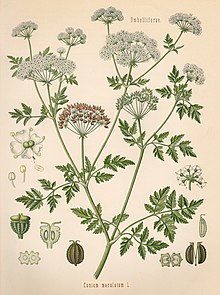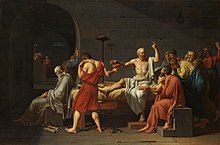Hemlock cup
Hemlock cup (Greek κώνειον kṓneion as the name of the plant and the drink made from it) is the name of the cup that in ancient times contained a drink made from the poisonous spotted hemlock , which was produced in the 5th and 4th centuries BC. Was used in Athens for executions. The fruit was peeled off, pounded and a thin layer of this powder was sprinkled on water. The condemned man emptied the cup and thereby brought about his own death. The term “hemlock cup” is mainly used to describe the execution of Socrates in 399 BC. Connected. Hemlock was also used for voluntary suicide.
There is a cocktail of the same name containing absinthe .
Mode of action
In the event of poisoning, the coniin contained in it causes paralysis of the spinal cord , which rises from the feet and can ultimately lead to death from respiratory paralysis . The poisoned man suffocated while fully conscious.
Coniin reversibly blocks nicotinic acetylcholine receptors and prevents signal transmission between cells. It looks very similar to curare and other toxins associated with acetylcholine receptors interact as anatoxin-a some cyanobacteria , nicotine , arecoline of betel nuts , cytisine of laburnum and Epibatidin of poison dart frog .
Application in ancient times
In the late 5th and 4th centuries BC The execution by the hemlock was common in Athens . Many executions were carried out in this way, particularly under the rule of the Thirty (404–403 BC) . Well-known persons who were executed in this way include Socrates, the politician Theramenes , Polemarchus, the brother of the speaker Lysias , the statesman Phokion and his friend Nicocles as well as the politicians Thudippos, Hegemon and Pythocles, who together with Phokion and Nicocles in 318 BC . Drank the hemlock cup.
Plato's detailed account of the execution of Socrates in his dialogue Phaedo is designed literary. According to the view traditionally dominating in research, it is heavily embellished. The description of the effects of the plant poison is correct in the main, but repulsive aspects are kept silent. The process of dying is accompanied by cramps and shortness of breath, and finally death by asphyxiation occurs. These unsightly side effects are Phaidon indicated very carefully. Phaedo reports that Socrates covered his face. If this is the case, then the philosopher wanted to spare his friends the sight of the convulsive distortion of facial features. The casual mention of a twitch in the body is arguably a subtle reference to the convulsions. The portrayal of the paralysis slowly rising in the body from below, the side effect of which is numbness, is an essential aspect of the embellished portrayal; it should illustrate the calm escape of the soul from the body. However, in a detailed study published in 2002, Enid Bloch contradicts the widespread assumption that the process could not have taken place in the manner described by Plato. She considers Plato's account to be a credible report that correctly gives the details of the poisoning.
If the condemned person was to be killed painlessly, anesthetic poppy seed extract was added to the hemlock cup . The first known mixture of this kind is from Thrasyas from Mantinea around 370 BC. Chr. Described.
literature
- Renate Wittern : The poison of the pious way of thinking - On the pharmacology of hemlock in antiquity . In: Erika Hickel , Gerald Schröder (ed.): New contributions to the history of medicines . Wissenschaftliche Verlagsgesellschaft, Stuttgart 1982, ISBN 3-8047-0687-8 , pp. 15-28.
- Christopher Gill: The Death of Socrates . In: The Classical Quarterly 23, 1973, pp. 25-28.
- Hans Gossen : Hemlock . In: Paulys Realencyclopadie der classischen Antiquity Science (RE). Supplementary Volume VIII, Stuttgart 1956, Col. 706-710.
- Kurt Hildebrandt , Constantin Ritter, Gustav Schneider (eds.): Platon all dialogues, Volume II, Dialog Phaidon , published by Felix Meiner in Leipzig.
Web links
Remarks
- ^ A. Trautmann: Curare can open and block ionic channels associated with cholinergic receptors. In: Nature. Volume 298, Number 5871, July 1982, pp. 272-275, PMID 6283380 .
- ↑ R. Aráoz, J. Molgó, N. Tandeau de Marsac: Neurotoxic cyanobacterial toxins. In: Toxicon . Volume 56, Number 5, October 2010, pp. 813-828, doi : 10.1016 / j.toxicon.2009.07.036 , PMID 19660486 (review).
- ↑ I. Yamamoto, JE Casida: Nicotinoid Insecticides and the Nicotinic Acetylcholine Receptor . Springer Science & Business Media, July 01, 1999, ISBN 978-4-431-70213-9 .
- ↑ KC Raffaele, A. Berardi, PP Morris, S. Asthana, JV Haxby, MB Schapiro, SI Rapoport, TT Soncrant: Effects of acute infusion of the muscarinic cholinergic agonist arecoline on verbal memory and visuo-spatial function in dementia of the Alzheimer type. In: Progress in neuro-psychopharmacology & biological psychiatry. Volume 15, Number 5, 1991, pp. 643-648, PMID 1956992 .
- ^ RL Papke, F. Ono, C. Stokes, JM Urban, RT Boyd: The nicotinic acetylcholine receptors of zebrafish and an evaluation of pharmacological tools used for their study. In: Biochemical pharmacology. Volume 84, number 3, August 2012, pp. 352–365, doi : 10.1016 / j.bcp.2012.04.022 , PMID 22580045 , PMC 3372685 (free full text).
- ↑ V. Gerzanich, X. Peng, F. Wang, G. Wells, R. Anand, S. Fletcher, J. Lindstrom: Comparative pharmacology of epibatidine: a potent agonist for neuronal nicotinic acetylcholine receptors. In: Molecular pharmacology. Volume 48, Number 4, October 1995, pp. 774-782, PMID 7476906 .
- ↑ Lysias 18:24; Andokides 3.10.
- ↑ Xenophon , Hellenika 2,3,56.
- ↑ Lysias 12:17.
- ↑ Plutarch , Phokion 35 f.
- ^ Theodor Ebert : Plato: Phaidon. Translation and Commentary , Göttingen 2004, p. 461; Renate Wittern: The poison of the pious way of thinking - On the pharmacology of hemlock in antiquity . In: Erika Hickel, Gerald Schröder (eds.): New contributions to the history of pharmaceuticals , Stuttgart 1982, pp. 15–28, here: 16 f .; Christopher Gill: The Death of Socrates . In: The Classical Quarterly 23, 1973, pp. 25-28.
- ^ Enid Bloch: Hemlock Poisoning and the Death of Socrates: Did Plato Tell the Truth? In: Thomas C. Brickhouse, Nicholas D. Smith (eds.): The Trial and Execution of Socrates: Sources and Controversies , Oxford 2002, pp. 255-278.


